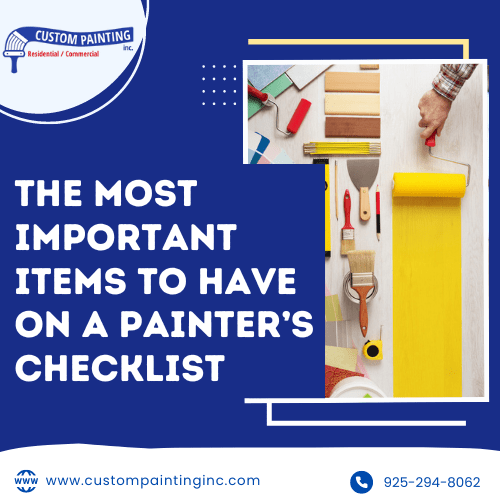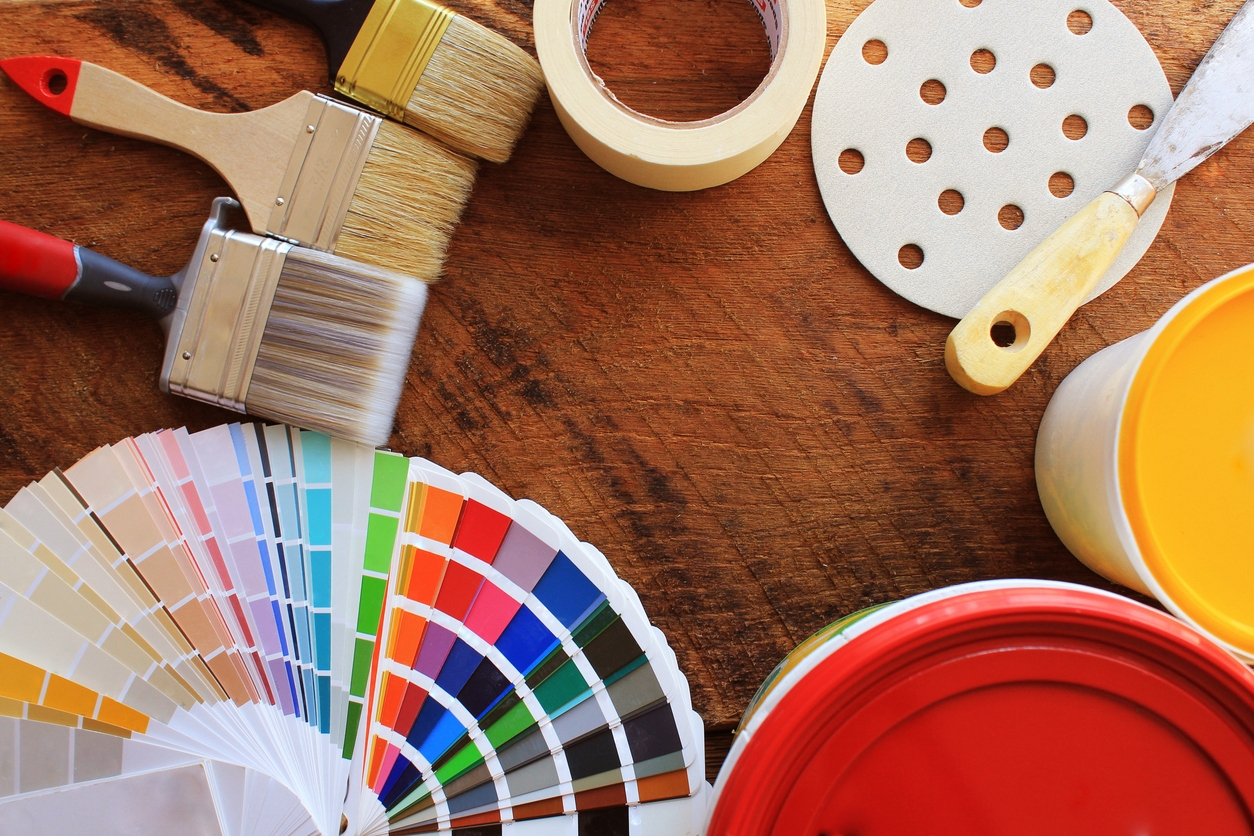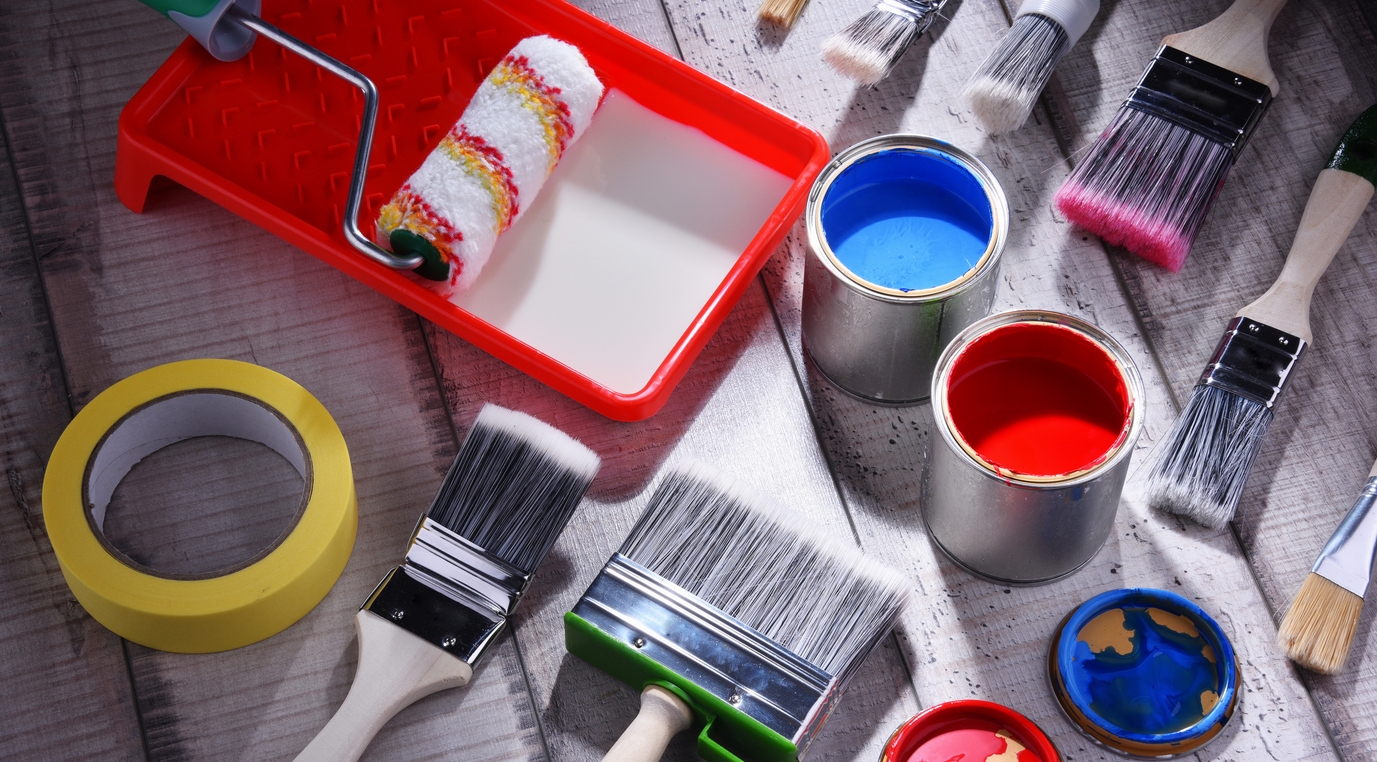Preparation is important when planning to paint a home or commercial space to achieve a flawless finish. Having a well-organized checklist ensures that all needed items are on hand. This helps minimize delays and enhances efficiency.
In this article, we’ll explore the most important items that need to be on every painter’s checklist. These include the essential tools and materials, safety equipment, and finishing touches. This guide will help painters tackle their projects with confidence, knowing they are fully prepared for every step of the process.
Pre-Preparation Tools and Materials
Proper preparation not only ensures a smooth painting experience but also guarantees a professional and durable finish. Having the right tools and materials ready can make a significant difference in the efficiency and quality of the project. Here are the different tools and materials needed for the pre-preparation stage:
- Drop Cloths and Plastic Sheeting: These are used to protect floors, furniture, and other surfaces from paint splatters and spills. Drop cloths are usually made of canvas and are durable and reusable. Plastic sheeting is lightweight and easy to tape down. It is ideal for covering furniture, windows, and fixtures.
- Painter’s Tape: This is used to create clean, sharp edges and prevent paint from bleeding onto unwanted areas. It is available in different widths. It is essential for masking off trim, baseboards, and other areas that require precise lines. It’s easy to apply and remove without damaging surfaces.
- Sandpaper and Sanding Blocks: These are used to smooth out surfaces and remove any existing imperfections or old paint. Sanding ensures that the new paint adheres properly. Sandpaper comes in various grits, with lower numbers for rough sanding and higher numbers for fine finishing. Sanding blocks provide a more comfortable grip and even pressure.
- Cleaning Solutions and Rags: These are used to clean surfaces and remove dust, grease, and grime before painting. Proper cleaning is crucial for paint adhesion. Use a mild detergent solution for general cleaning and a degreaser for tougher areas. Rags and microfiber cloths help wipe down surfaces effectively.
- Scrapers and Putty Knives: These are used to remove old paint, wallpaper, and debris and to apply and smooth out filler materials. Scrapers are used to strip away old paint or wallpaper, while putty knives are essential for applying spackle or joint compound to fill holes and cracks. Ensure you have various sizes for different tasks.
- Spackling Paste and Joint Compound: These are used to fill in holes, cracks, and imperfections in walls and surfaces. Spackling paste is suitable for smaller holes and cracks, while joint compound is used for larger repairs. Both need to be sanded smooth after drying to create a seamless surface for painting.
- Primer: This is used to create a uniform base for the topcoat and improve paint adhesion. Primer is essential for sealing porous surfaces, covering stains, and providing a consistent foundation for the final paint color. It’s particularly important for new drywall, bare wood, or areas with significant repairs.
- Paint Stir Sticks and Mixing Tools: These are used to ensure that the paint is thoroughly mixed for a consistent color and finish. Paint stir sticks are simple yet essential for manual mixing, while mechanical mixers can be attached to drills for larger quantities. Proper mixing prevents color variations and ensures even application.
Painting Tools
Having the right painting tools is crucial for achieving a smooth, professional finish. Each tool serves a specific purpose, and understanding their uses can greatly enhance the quality and efficiency of any painting project. Below are the essential painting tools that every painter should have on their checklist.
1. Brushes and Rollers
Each type of brush and roller is designed to handle specific paint types and surface textures. Using the correct tool ensures even coverage and minimizes streaks and lines.
Types of Brushes:
- Angle Sash Brushes: Ideal for cutting in along edges and corners, providing precise control.
- Flat Brushes: Best for covering large, flat surfaces with a smooth finish.
- Detail Brushes: Used for intricate work and small areas that require careful attention.
Types of Rollers:
- Foam Rollers: Perfect for applying gloss or semi-gloss paints, especially on smooth surfaces.
- Nap Rollers: Available in various nap lengths, with short nap rollers suited for smooth surfaces and longer naps for textured walls and ceilings.
- Mini Rollers: Great for tight spaces and smaller projects.
2. Extension Poles and Ladders
Using extension poles and ladders effectively helps painters reach high or awkward areas, ensuring even application across all surfaces.
- Extension Poles: These are used to extend the reach of rollers, allowing painters to cover high walls and ceilings without a ladder. Telescoping extension poles are adjustable to various lengths, providing flexibility for different heights.
- Ladders: Use step ladders for indoor projects and extension ladders for reaching exterior heights. Look for ladders with slip-resistant steps and sturdy construction to ensure safety and stability.
3. Paint Trays and Buckets
Proper use of paint trays and buckets helps maintain a clean workspace and improves efficiency by reducing downtime for refills.
- Paint Trays: These are used to hold and manage paint while using rollers, reducing the need to dip directly into the paint can. Trays with built-in ridges help remove excess paint from rollers, ensuring an even application.
- Buckets: These are ideal for larger projects. Paint buckets can hold more paint than trays, reducing the need for frequent refills. Some buckets come with built-in grids for roller use, similar to tray ridges, and lids for easy storage between sessions.
4. Safety Gear
Wearing the appropriate safety gear is crucial for protecting oneself from potential hazards associated with painting, ensuring a safe and comfortable working environment.
- Masks: These are important to protect you against inhaling harmful fumes and particulates. Use disposable masks for basic protection and respirators for more hazardous environments.
- Gloves: Use these to protect hands from paint, solvents, and chemicals. Latex or nitrile gloves are suitable for most painting tasks, providing flexibility and chemical resistance.
- Goggles: These are used to protect eyes from splashes and debris. Look for goggles with a snug fit and anti-fog coating to maintain clear vision.
Paint and Color Supplies
Selecting the right paint and color supplies is fundamental to the success of any painting project. The variety of options available can be overwhelming, but understanding the different types and their specific uses can help painters make informed decisions. Here are the essential paint and color supplies that every painter should consider.
Types of Paint
- Latex Paint: This type of paint is ideal for interior walls and ceilings. It is water-based, quick-drying, low odor, and easy to clean with soap and water. It provides a durable finish and is available in various sheens, from matte to high-gloss.
- Oil–Based Paint: This is suitable for trim, doors, and surfaces that require a durable, hard finish. However, it takes longer to dry, has a strong odor, and requires mineral spirits for cleanup. It provides a smooth, high-gloss finish and is excellent for areas subject to heavy wear.
- Acrylic Paint: This type of paint is versatile for both interior and exterior surfaces. It is water-based, like latex paint, but with added durability and flexibility, making it resistant to cracking and peeling. It’s ideal for wood, masonry, and metal.
- Specialty Paints: These are designed for specific applications, such as chalkboard paint, metallic finishes, or anti-mold paint. Each specialty paint offers unique properties tailored to particular needs, like creating writable surfaces or resisting moisture in high-humidity areas.
Paint Finishes
- Matte/Flat: This paint finish provides a non-reflective finish, ideal for hiding imperfections. It is best for ceilings and low-traffic areas.
- Eggshell: This finish offers a slight sheen and more durability than a matte finish. It is suitable for living rooms, dining rooms, and bedrooms.
- Satin: A satin finish provides a smooth and velvety finish with moderate sheen and good durability. It is great for high-traffic areas like hallways, kitchens, and bathrooms.
- Semi-Gloss: This offers a shiny finish with excellent durability and ease of cleaning. It is ideal for trim, doors, and cabinets.
- High-Gloss: This paint finish provides a highly reflective and durable finish. It is best for areas that need frequent cleaning, such as doors, trim, and furniture.
Color Supplies
- Color Charts and Samples: These are used to help choose and visualize colors.
- Tinting and Mixing Tools: These are used to achieve the perfect color match or create custom shades.
- Sealants and Varnishes: These are used to protect painted surfaces and enhance durability.
Cleanup and Maintenance Equipment
A successful painting project doesn’t end once the paint is applied. Proper cleanup and maintenance are essential to preserve the quality of the work and extend the lifespan of tools and materials. Here, we explore the key equipment needed for effective cleanup and ongoing maintenance.
Cleanup Equipment
- Paint Thinners and Solvents: These are used to clean oil-based paint from brushes, rollers, and other equipment. Common types include mineral spirits, turpentine, and acetone.
- Brush and Roller Cleaners: These tools often have combs or wire brushes to thoroughly clean paint from brushes and rollers, preserving their usability.
- Buckets and Wash Basins: Large containers used to rinse and clean tools and accessories with water or solvent.
- Scrapers and Wire Brushes: These are used to remove dried paint from tools and surfaces. They are available in various sizes and shapes for different cleaning tasks.
- Disposable Gloves: Made of latex, nitrile, or vinyl, these gloves protect hands from harsh chemicals and paint during the cleanup process.
- Rags and Paper Towels: Microfiber cloths, old cotton rags, and heavy-duty paper towels are used to wipe down tools, spills, and surfaces to absorb excess paint.
- Soap and Water: These are essential for cleaning water-based (latex and acrylic) paints from brushes, rollers, and surfaces, using mild detergents and warm water.
Maintenance Equipment
- Brush and Roller Storage Containers: These airtight containers or specially designed storage systems keep bristles and roller fibers in optimal condition between uses.
- Tool Organizers: Toolboxes, caddies, and wall-mounted organizers help maintain order and prevent damage to painting tools.
- Protective Coatings for Tools: Rust inhibitors and protective oils are applied to the metal parts of tools to prevent rust and corrosion and extend their lifespan.
- Blade Sharpeners: Simple handheld sharpeners or more sophisticated sharpening systems keep scrapers and utility knife blades effective for precise work.
- Lubricants: Multi-purpose lubricants like WD-40 ensure smooth operation and prevent wear and tear on moving parts of tools such as extension poles and sprayers.
- Replacement Parts: Extra roller covers, brush heads, and scraper blades ensure that tools remain effective without needing complete replacements.
Conclusion
Proper cleanup and maintenance are crucial for extending the life of your painting tools and achieving professional results. By using the right equipment and taking care of your tools, you can ensure they remain effective for future projects. For more tips and professional painting services, contact Custom Painting, Inc. at 925-686-0903 or fill out the contact form on our website.




